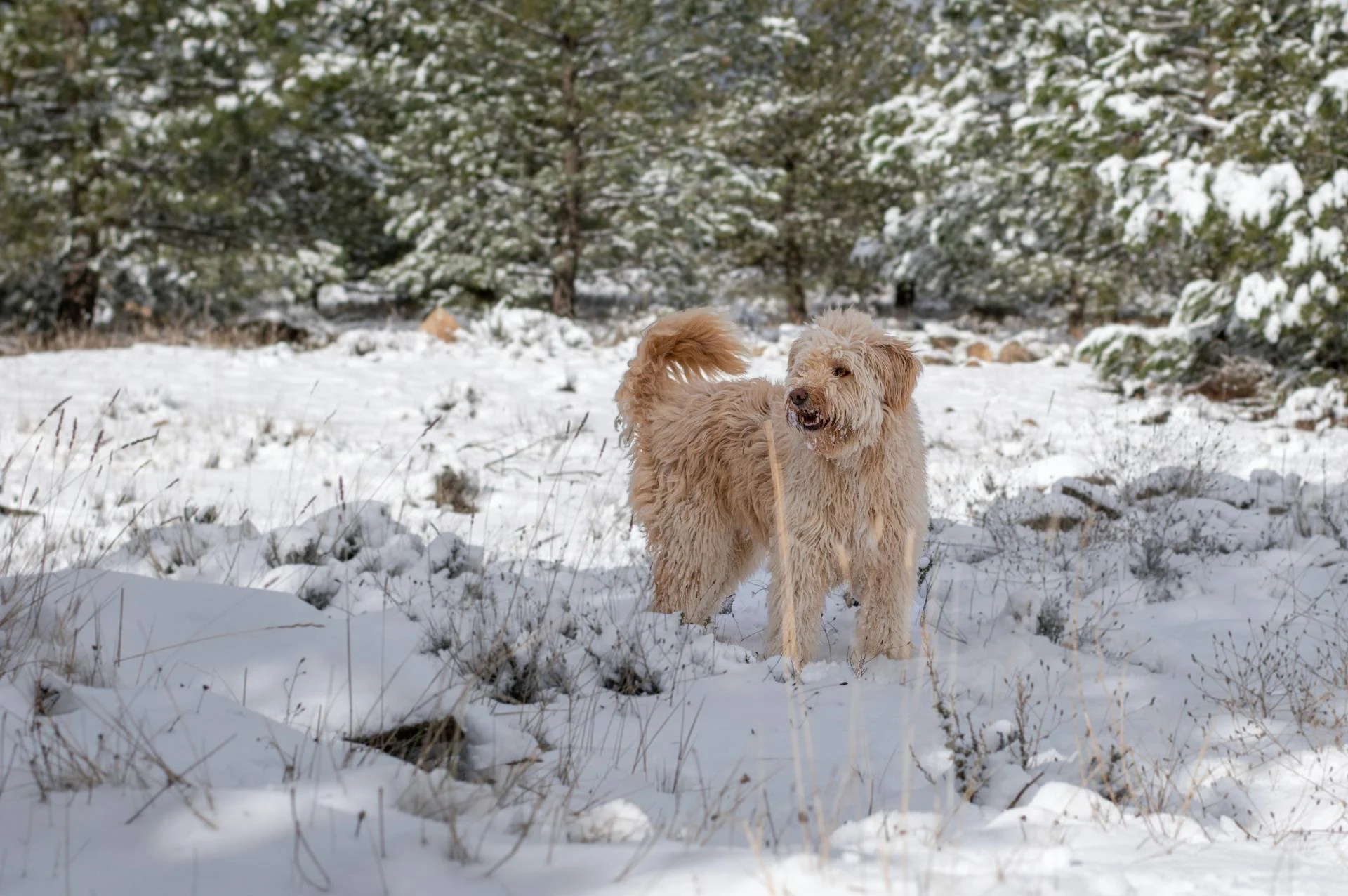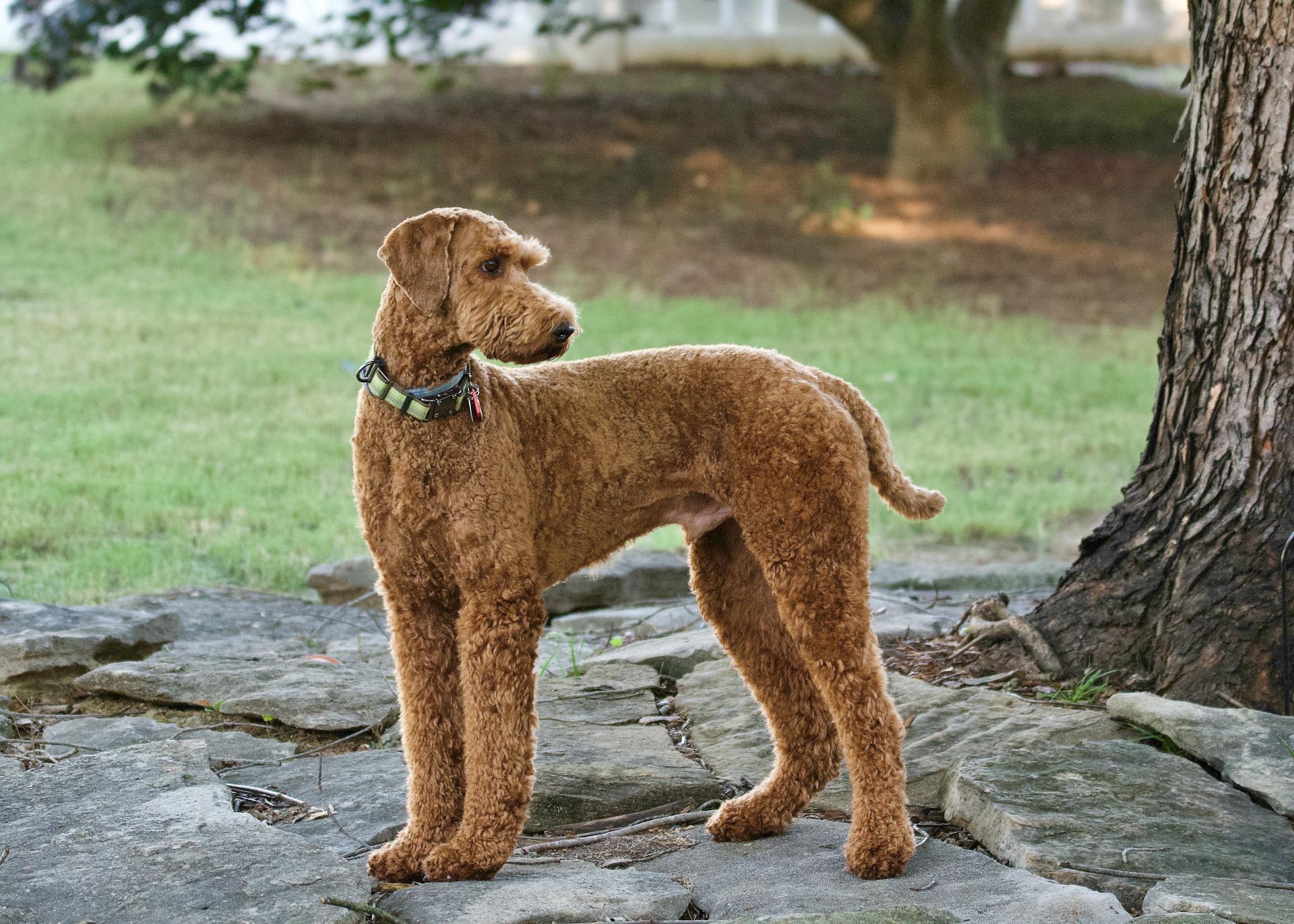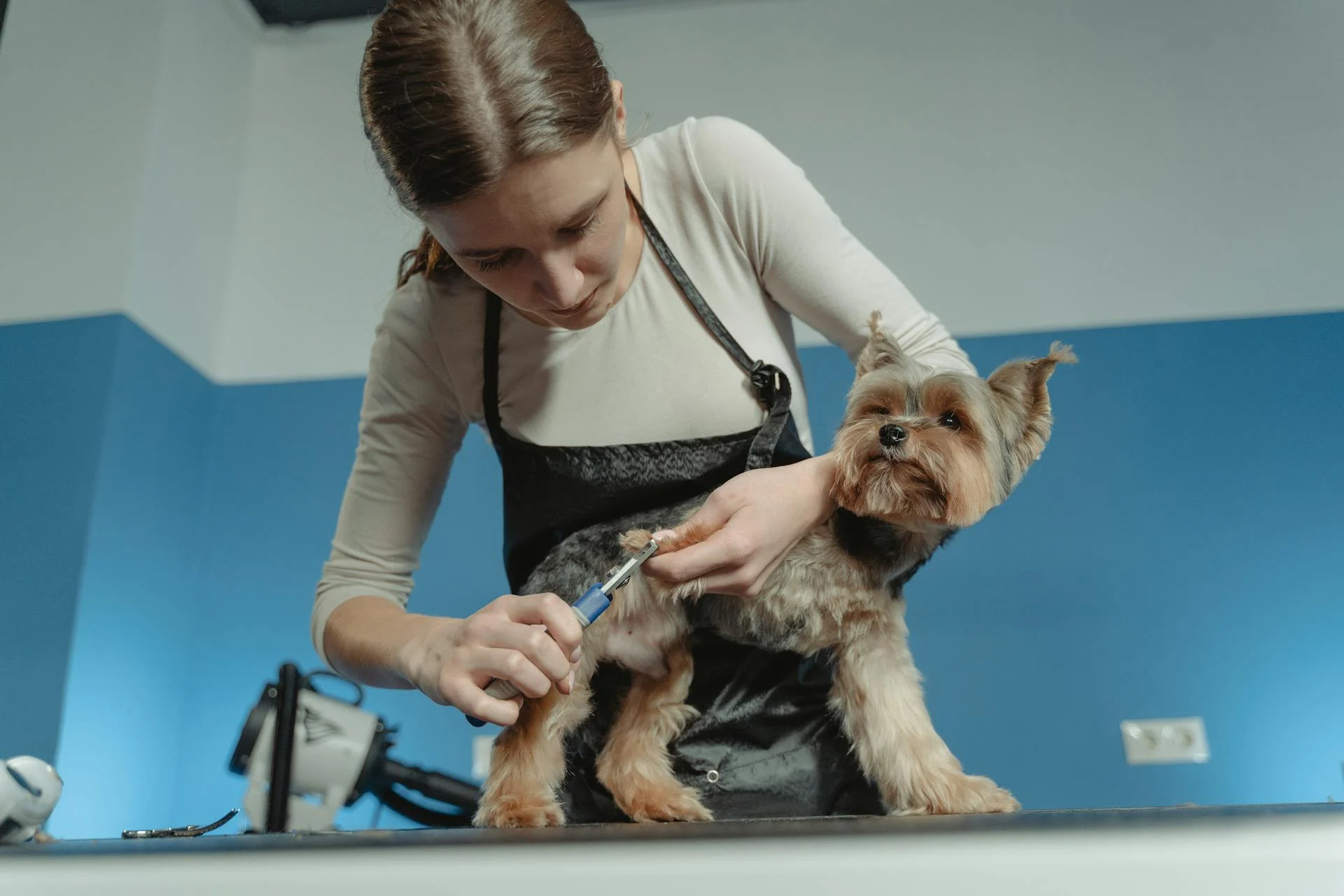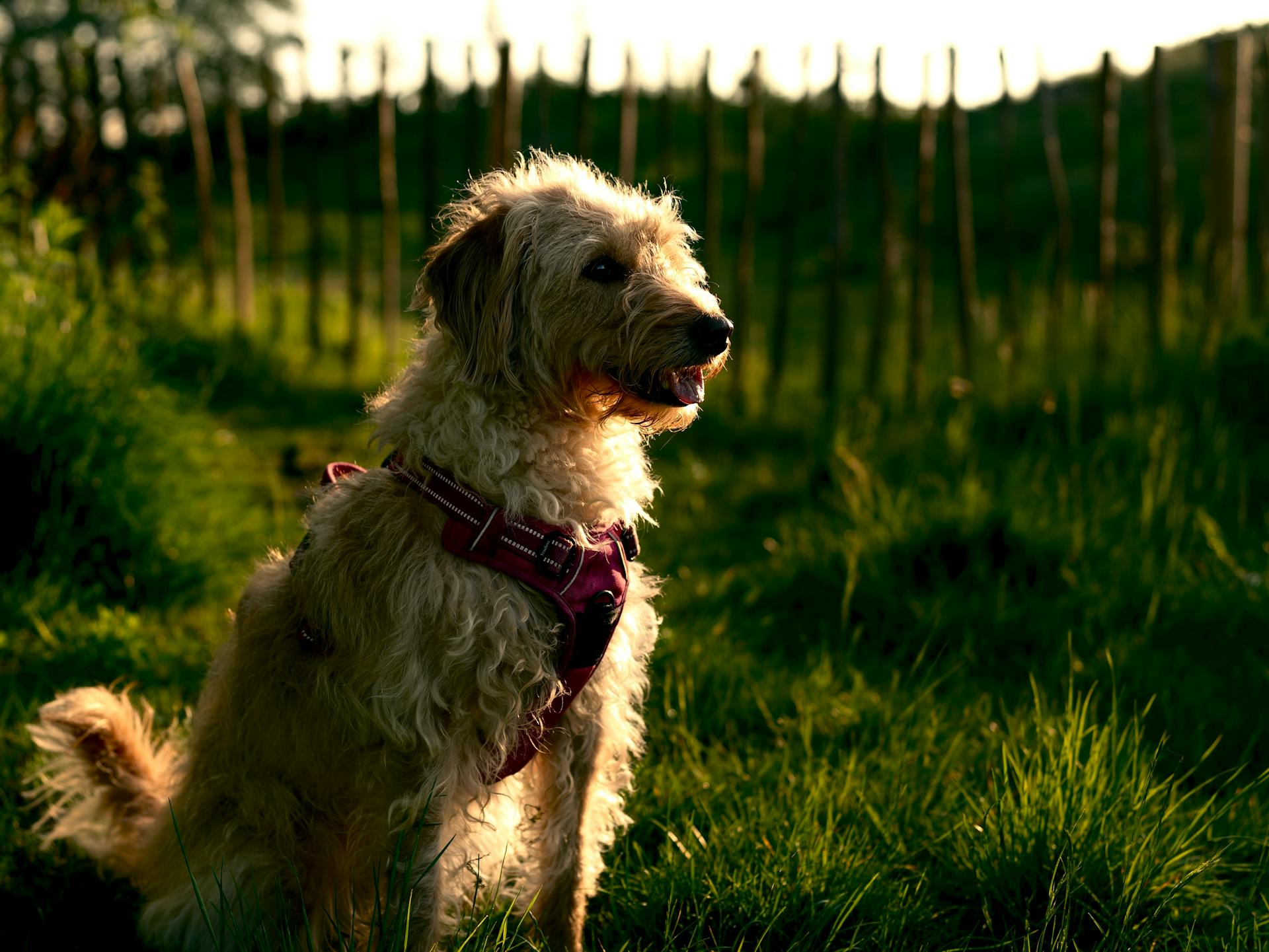
Labradoodles are a popular crossbreed between a Labrador Retriever and a Poodle, known for their friendly and outgoing personalities.
Labradoodles are generally considered a low-shedding breed, making them a great choice for people with allergies.
They come in a variety of sizes, including toy, miniature, and standard, which can affect their energy levels and exercise needs.
Labradoodles are highly intelligent and easy to train, but they can be prone to separation anxiety if left alone for too long.
The History of
The Labradoodle breed was first introduced by Australian breeder Wally Conron in the late 1980s. Conron was in charge of the breeding program for the Royal Guide Dogs Association of Australia.
Conron's goal was to create a guide dog that was suitable for people with allergies to fur and dander. He achieved this by crossing a Standard Poodle with a Labrador Retriever, resulting in the first Labradoodle, Sultan.
Sultan worked successfully as a guide dog for a woman in Hawaii, displaying the qualities Conron was seeking. Conron's initial intention was to create a catch-all name and marketing strategy to sell his litter.
Broaden your view: Labradoodle
The Labradoodle quickly gained popularity, and other breeders began crossing Labrador Retrievers with Poodles to produce the breed. The Australian Labradoodle Association and the International Australian Labradoodle Association are now working to move the breed into registered breed status.
However, Conron has since expressed regret over initiating the fashion for this type of crossbreed. He believes it has caused "a lot of damage" and "a lot of problems" due to the genetic unpredictability of combining breeds.
Suggestion: Australian Labradoodles vs Labradoodles
Breed Characteristics
Labradoodles are known for being friendly and intelligent dogs. They are good with children and other animals, and they are easy to train.
Their coats can vary in texture, from wiry to soft, and may be straight, wavy, or curly. They often display an affinity for water and strong swimming ability from their parent breeds.
Labradoodles are highly trainable, often excelling in obedience. Consistent, positive reinforcement methods work well with this breed.
Here are some key characteristics of Labradoodles:
- Size: Medium to Large
- Coat: Can vary (curly, wavy, or straight), usually low shedding
- Temperament: Friendly, intelligent, and social
- Exercise Needs: Moderate to High
- Grooming: Regular grooming needed to prevent matting
Their lifespan is typically 10 to 15 years. They are loyal and devoted dogs that make great companions, always happy to see their owners and loving to cuddle.
Appearance and Temperament
Labradoodles come in a wide range of appearances due to their mixed breed heritage. Their hair can be anywhere from wiry to soft, and may be straight, wavy, or curly.
Labradoodles often display an affinity for water and strong swimming ability from their parent breeds, the Labrador Retriever and Poodle. This makes them well-suited for families who enjoy water activities.
Labradoodles are generally friendly, energetic, and good with families and children. They are also highly intelligent and likely to destroy or chew if not properly mentally and physically fulfilled.
Here are some common characteristics of Labradoodles:
Size
Labradoodles come in a range of sizes, depending on the size of the Poodle used for breeding. The three main sizes are Standard, Medium, and Miniature.
The Standard Labradoodle typically stands between 22 to 24 inches tall for males and 21 to 23 inches tall for females, weighing between 50 to 65 pounds.
Medium Labradoodles are slightly smaller, standing between 18 to 20 inches high for males and 17 to 19 inches high for females, weighing between 30 to 45 pounds.
Intriguing read: Medium Breeds Dogs
Miniature Labradoodles are the smallest of the three, with an average height of 14 to 16 inches and weighing between 15 to 25 pounds.
Labradoodles can have varying coat types, including straight-coated, wavy-coated, and curly-coated dogs, with wool coats having tight curls similar to a poodle's coat but with a softer texture.
On a similar theme: Flat Coat Doodle
Coat Texture and Color
Labradoodles have three main coat textures: wool, fleece, or hair. The wool coat is dense and similar to a lamb's wool, while the fleece coat has a silky texture often described as an Angora goat texture.
The hair coat, on the other hand, is similar to fur in shedding breeds and sheds, often having a normal doggy odor. It's worth noting that hair coats are less popular among breeders.
Here are the three main coat textures and their characteristics:
- Wool Coat: dense, similar to a lamb's wool, nonshedding, and usually non-odorous
- Fleece Coat: silky texture, often described as an Angora goat texture, ranging from straight to wavy
- Hair Coat: similar to fur in shedding breeds, sheds, and often has a normal doggy odor
Labradoodles come in a wide variety of colors, including gold, apricot, caramel, chalk, black, red, café, cream, silver, chocolate, parchment, and blue. They can also have parti-colored coats, which consist of brindles, phantom, patched, or sable colors.
Coat Color and Grooming
Labradoodles come in a wide range of coat colors, including chocolate, cafe, parchment, cream, gold, apricot, red, black, silver, chalk, lavender, and blue-ish gray. Their coat patterns can be solid, white abstract markings, parti, phantom, or tri-coloured.
Labradoodles have a single coat with hair ranging from straight to loose curls. They are considered to be non- to low shedders, especially those with a Fleece or Wool coat. Hair coats tend to shed just as they do in other breeds, ranging from very low to average shedding.
You can expect to brush a Labradoodle about once or twice per week, depending on the length and type of their coat. Some Labradoodles can be clipped or trimmed every six to eight weeks to keep the coat easy to maintain.
Labradoodles come in three types of texture: Hair, Wool, and Fleece. Here's a brief description of each:
Labradoodles should only be bathed when necessary, as many of their coats don't have a noticeable doggy odor. It's also essential to dry and clean their ears regularly to prevent infections.
Breeding and Generations
Labradoodles have a few types, each with its own special traits. Knowing about their different generations is essential for finding the perfect furry friend.
Labradoodles can be F1, which is the first generation, or multigenerational, which is more predictable. F1 Labradoodles are often full of energy, making them a great match for active families.
Choosing the right generation depends on what you like and how you live. If you have allergies, a multigenerational Labradoodle might be a better choice, as they tend to be more hypoallergenic.
Related reading: F1 Labradoodles
Follow-on Guide Programs
Guide-dog breeding programs have been using labradoodles for some time now, but it's worth noting that they're not considered a purebred breed by the AKC.
The AKC allows owners of mixed breeds to register their dogs through an alternative listing program, which can provide an AKC ID number.
Guide Dogs Victoria no longer breeds labradoodles, but other organizations in Australia and elsewhere still do.
You might enjoy: Akc Dog Types
Labradoodles are widely used as guide, assistance, and therapy dogs, and they're also popular family pets.
Some Australian labradoodle breeding programs have introduced other breeds into their ancestry, such as English and American cocker spaniel × poodle crosses.
Two Irish water spaniels and soft-coated Wheaten Terriers were used in some Australian labradoodle lines, but curly-coated Wheaten Retrievers were eventually phased out due to unsatisfactory results.
A fresh viewpoint: Austrian Labradoodles
Understanding Generations
Labradoodles have a few types, each with its own special traits. Knowing about their different generations is essential for those who adore Labradoodles.
The first Labradoodles made are called F1 Labradoodles, which are a 50-50 mix of a Labrador Retriever and a Poodle. They can look and act quite different.
Choosing the right Labradoodle generation depends on what you like and how you live. Think about things like allergies, how much energy you have, and what kind of Labradoodle you want.
F2 Labradoodles are the result of breeding two F1 Labradoodles together. They're predictable but still have some surprises.
Breeding Labradoodle to Labradoodle over successive generations is a common practice, and these dogs are usually referred to as multigenerational or multigen Labradoodles.
F1b
F1b Labradoodles are a result of breeding an F1 Labradoodle with a Poodle again, often producing curlier hair.
They're a great option for people with allergies, as their coats tend to be hypoallergenic.
F1b Labradoodles can exhibit a mix of characteristics from both parent breeds, making each one unique.
On a similar theme: What Are F1b Labradoodles
Health and Care
Labradoodles can be prone to health issues common to their parent breeds, such as hip dysplasia and eye disorders.
They also require regular exercise, ideally 30 to 60 minutes per day, and a fenced yard to expel energy.
Labradoodles are intelligent and energetic, so they need intellectual stimulation to prevent boredom and destructive behavior.
Crate training is beneficial for Labradoodles, allowing them to retreat for naps and preventing accidents in the house.
However, it's essential not to leave them in a crate all day, as it's not a substitute for human interaction and exercise.
Labradoodles can thrive in suburban or city environments, but they do need regular care and attention to stay happy and healthy.
By following proper care and exercise routines, you can help prevent common health issues and ensure your Labradoodle lives a long and healthy life.
Health Essentials

Labradoodles can be prone to hip dysplasia, a common problem in their parent breeds. This can lead to arthritis and mobility issues later in life.
Regular veterinary check-ups are crucial to detect any potential health issues early on. Take your Labradoodle to the vet for shots, teeth checks, and to prevent bugs.
Labradoodles may be susceptible to eye disorders and neurological problems, including epilepsy, which can be inherited from their parent breeds. These conditions can be unpredictable, even with responsible breeding practices.
A reputable breeder will be honest about health problems in the breed and provide evidence of genetic testing on their dogs. They should have certifications from health registries like the Orthopedic Foundation for Animals and Canine Eye Registry Foundation.
Keeping your Labradoodle at an appropriate weight is one of the easiest ways to extend their life. Obesity is a common health problem that can be prevented with a balanced diet and regular exercise.
Grooming
Grooming is an essential part of Labradoodle care. Regular grooming helps prevent matting and tangling of their fur, reduces shedding, and keeps their coat looking healthy and shiny.
Labradoodles have three main coat types: Hair, Wool, and Fleece. Each type requires different grooming needs. For example, Fleece coats are soft and silky, while Wool coats are denser and non-shedding.
To maintain their coat, brush your Labradoodle about once or twice a week, depending on their coat type and length. Some Labradoodles may require more frequent brushing, especially if they have long hair.
Labradoodles are prone to ear infections, so it's crucial to keep their ears clean and dry, especially after swimming or bathing. Check their ears weekly for dirt, redness, or a bad odor that could indicate an infection.
Bathing your Labradoodle too frequently can dry out their skin and cause itchiness. Bathe them only when they're visibly dirty or smelly. Regular nail trimming, every week or two, is also essential to prevent overgrowth.
For more insights, see: Do Labradoodles Need to Be Groomed
To prevent gum disease and associated issues, brush your Labradoodle's teeth as often as possible, ideally daily.
Here's a summary of Labradoodle grooming needs:
Regular grooming sessions can be a great opportunity to check for lumps, bumps, and parasites, as well as to examine their paws, nose, mouth, and eyes for any signs of health issues.
Care and Feeding
Labradoodles require a significant amount of exercise, about 30 to 60 minutes per day, and need a fenced yard to expel energy. Consistency and positive reinforcement are key to easy training.
They are intelligent and eager-to-please dogs, but can become destructive if bored. Crate training is beneficial, but should not be used as a substitute for regular exercise and mental stimulation.
To ensure your Labradoodle's physical and mental health, feed them 1 to 2.5 cups of high-quality dry food per day, divided into two meals. Keep an eye on their weight by using portion control and limiting snacks, as they can be prone to obesity.
If this caught your attention, see: Labradoodles Training
Here are some general guidelines for Labradoodle nutrition:
Regular grooming is also essential, including brushing their teeth at least two or three times a week to prevent tartar buildup and gum disease. Trim their nails once or twice a month to prevent painful tears and other problems.
Caring for Your
Labradoodles require regular exercise, aiming for 30 to 60 minutes per day, and a fenced yard is ideal to burn off energy. They make excellent jogging companions and need time off-leash to expel steam.
Their intelligence and eagerness to please make training easy with consistency and positive reinforcement. Crate training benefits every dog, ensuring no accidents in the house and providing a safe space for naps.
Labradoodles are people dogs and shouldn't spend their lives locked up in a crate or kennel. They need socialization from puppyhood to interact with other dogs.
To keep their coats looking their best, Labradoodles need regular grooming. Brushing should be done at least every other day, with a slicker brush, and clipping every 8 to 12 weeks.

Their ears are prone to infections, so it's essential to keep them dry and clean, especially after baths or swimming. Regular ear cleaning with a cotton ball and gentle ear cleaner will help prevent problems.
Labradoodles' grooming requirements vary depending on their coat type, but regular maintenance is essential. They come in three coat varieties: hair coat, wool coat, and fleece coat, each with its own unique characteristics.
Labradoodles are low to non-shedding, making them a good pet for people with allergies. However, they still need regular grooming to prevent matting and tangling.
Here's a quick rundown of Labradoodles' grooming needs:
Labradoodles also need their teeth brushed regularly to prevent gum disease and associated issues. Daily brushing is ideal, but at least twice a week is recommended.
By following these grooming tips and providing regular exercise and socialization, you'll be well on your way to raising a happy and healthy Labradoodle.
Feeding
When I first got my Labradoodle, I was amazed at how much food they went through. Labradoodles need a lot of fuel to keep them running, and the right amount of food can make all the difference.
Here's an interesting read: Best Food for Labradoodles

A good rule of thumb is to feed your adult Labradoodle 1 to 2.5 cups of high-quality dry food per day, divided into two meals. This amount can vary depending on their size, age, build, metabolism, and activity level, so it's essential to monitor their weight and adjust their food intake accordingly.
You should be able to see a waist on your Labradoodle when you look down at them, and if you place your hands on their back, you should be able to feel but not see their ribs without having to press hard.
Feeding your Labradoodle twice a day can also lower their risk of gastric torsion, also known as bloat, which is a serious condition that can be life-threatening.
To keep your Labradoodle's teeth healthy, brush them at least two or three times a week to remove tartar buildup and bacteria. Daily brushing is even better, but if you're not experienced, you can start with a few times a week and gradually increase the frequency.
Trimming your Labradoodle's nails is also crucial to prevent painful tears and other problems. If you can hear their nails clicking on the floor, they're too long, and it's time to trim them.
Here's a quick guide to help you keep track of your Labradoodle's feeding schedule:
Remember, every dog is different, and what works for one Labradoodle may not work for another. Always consult with your vet for personalized advice on feeding your furry friend.
Frequently Asked Questions
What is the downside to a Labradoodle?
Labradoodles require regular exercise to stay healthy and happy, making them unsuitable for busy owners. Without enough physical activity, they may develop behavioral issues or depression.
Is a Labradoodle a good house dog?
Labradoodles are excellent family pets, known for their calm and social nature, making them a great addition to any household. They're perfect for families with kids who love playing with their pets.
Why is a Labradoodle so expensive?
Labradoodles are often expensive due to the time and effort invested in their breeding process. Reputable breeders put a lot of care into creating these unique dogs, which contributes to their higher cost.
What is a lab a doodle?
A Labradoodle is a crossbreed between a Labrador Retriever and a Poodle, known for its friendly, intelligent, and energetic personality. This unique breed makes a great choice for families and first-time dog owners.
Featured Images: pexels.com


